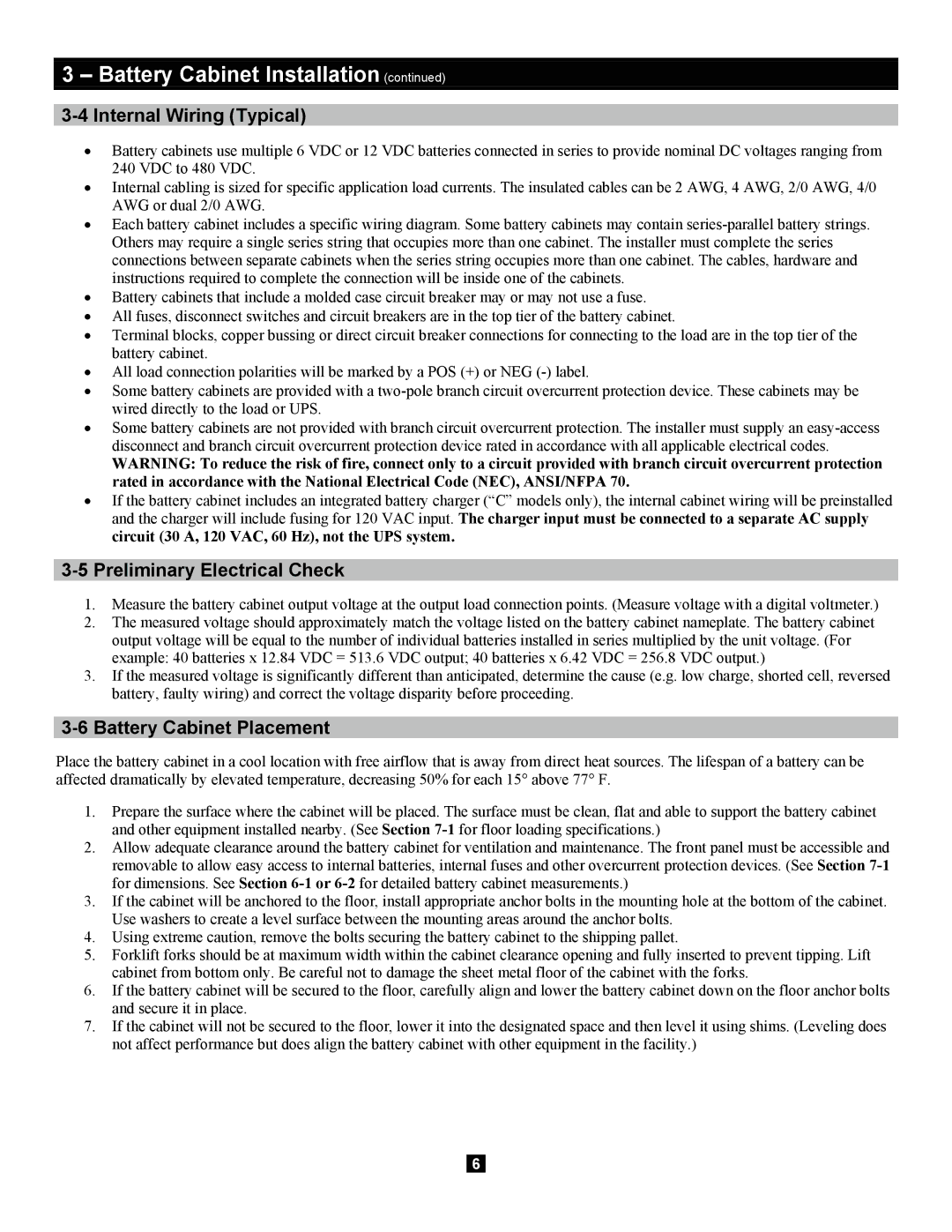
3 – Battery Cabinet Installation (continued)
3-4 Internal Wiring (Typical)
•Battery cabinets use multiple 6 VDC or 12 VDC batteries connected in series to provide nominal DC voltages ranging from 240 VDC to 480 VDC.
•Internal cabling is sized for specific application load currents. The insulated cables can be 2 AWG, 4 AWG, 2/0 AWG, 4/0 AWG or dual 2/0 AWG.
•Each battery cabinet includes a specific wiring diagram. Some battery cabinets may contain
•Battery cabinets that include a molded case circuit breaker may or may not use a fuse.
•All fuses, disconnect switches and circuit breakers are in the top tier of the battery cabinet.
•Terminal blocks, copper bussing or direct circuit breaker connections for connecting to the load are in the top tier of the battery cabinet.
•All load connection polarities will be marked by a POS (+) or NEG
•Some battery cabinets are provided with a
•Some battery cabinets are not provided with branch circuit overcurrent protection. The installer must supply an
WARNING: To reduce the risk of fire, connect only to a circuit provided with branch circuit overcurrent protection rated in accordance with the National Electrical Code (NEC), ANSI/NFPA 70.
•If the battery cabinet includes an integrated battery charger (“C” models only), the internal cabinet wiring will be preinstalled and the charger will include fusing for 120 VAC input. The charger input must be connected to a separate AC supply circuit (30 A, 120 VAC, 60 Hz), not the UPS system.
3-5 Preliminary Electrical Check
1.Measure the battery cabinet output voltage at the output load connection points. (Measure voltage with a digital voltmeter.)
2.The measured voltage should approximately match the voltage listed on the battery cabinet nameplate. The battery cabinet output voltage will be equal to the number of individual batteries installed in series multiplied by the unit voltage. (For example: 40 batteries x 12.84 VDC = 513.6 VDC output; 40 batteries x 6.42 VDC = 256.8 VDC output.)
3.If the measured voltage is significantly different than anticipated, determine the cause (e.g. low charge, shorted cell, reversed battery, faulty wiring) and correct the voltage disparity before proceeding.
3-6 Battery Cabinet Placement
Place the battery cabinet in a cool location with free airflow that is away from direct heat sources. The lifespan of a battery can be affected dramatically by elevated temperature, decreasing 50% for each 15° above 77° F.
1.Prepare the surface where the cabinet will be placed. The surface must be clean, flat and able to support the battery cabinet and other equipment installed nearby. (See Section
2.Allow adequate clearance around the battery cabinet for ventilation and maintenance. The front panel must be accessible and removable to allow easy access to internal batteries, internal fuses and other overcurrent protection devices. (See Section
3.If the cabinet will be anchored to the floor, install appropriate anchor bolts in the mounting hole at the bottom of the cabinet. Use washers to create a level surface between the mounting areas around the anchor bolts.
4.Using extreme caution, remove the bolts securing the battery cabinet to the shipping pallet.
5.Forklift forks should be at maximum width within the cabinet clearance opening and fully inserted to prevent tipping. Lift cabinet from bottom only. Be careful not to damage the sheet metal floor of the cabinet with the forks.
6.If the battery cabinet will be secured to the floor, carefully align and lower the battery cabinet down on the floor anchor bolts and secure it in place.
7.If the cabinet will not be secured to the floor, lower it into the designated space and then level it using shims. (Leveling does not affect performance but does align the battery cabinet with other equipment in the facility.)
[6]
